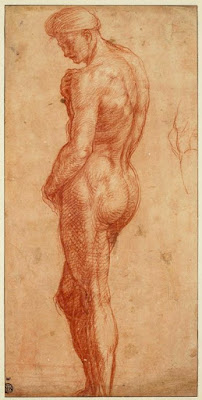 |
| Andrea del Sarto Virgin and Child enthroned with Eight Saints 1528 drawing Kupferstichkabinett, Staatliche Museen zu Berlin |
 |
| Andrea del Sarto Virgin and Child enthroned with Six Saints ca. 1528 oil on panel Palazzo Pitti, Florence |
 |
| Andrea del Sarto Virgin and Child enthroned with Six Saints (detail with St Sebastian) ca. 1528 oil on panel Palazzo Pitti, Florence |
 |
| Andrea del Sarto Head of a Child (study for young St John the Baptist) ca. 1529 drawing Musée du Louvre |
 |
| Andrea del Sarto Head of a Man, after the Antique (study for Apostle) before 1530 drawing Musée du Louvre |
 |
| Andrea del Sarto St John the Baptist in the Wilderness ca. 1520-30 oil on canvas Palazzo Pitti, Florence |
 |
| Andrea del Sarto Drapery Study before 1530 drawing Musée du Louvre |
 |
| Andrea del Sarto Drapery Study before 1530 drawing Musée du Louvre |
 |
| Andrea del Sarto Virgin and Child with St Elizabeth, young St John the Baptist and an Angel ca. 1515 oil on panel Alte Pinakothek, Munich |
 |
| Andrea del Sarto Virgin and Child with young St John the Baptist and Angels ca. 1517-19 oil on canvas Wallace Collection, London |
 |
| Andrea del Sarto Study of Model for Figure of St Joseph ca. 1525 drawing (study for fresco) Musée du Louvre |
 |
| Andrea del Sarto after Baccio Bandinelli Figure from Massacre of the Innocents ca. 1520-30 drawing Musée du Louvre |
 |
| Andrea del Sarto after Baccio Bandinelli Half-Length Figure Study ca. 1520-30 drawing Musée du Louvre |
 |
| Andrea del Sarto after Michelangelo Dragon devouring a Serpent before 1530 drawing Musée du Louvre |
 |
| Andrea del Sarto after Michelangelo Figure Study ca. 1510 drawing (study for fresco) Musée du Louvre |
 |
| follower of Andrea del Sarto Running Infant ca. 1520-30 drawing Musée du Louvre |
Andrea del Sarto (1486-1530) – The leading painter in Florence from c. 1510. Influenced by Fra Bartolommeo (whom he displaced in importance both as executant and teacher), Leonardo, Michelangelo, Raphael, contemporary Norther prints (Dürer, Lucas van Leyden), and by 15th-century Florentine tradition, he evolved a complex but harmonious individual style combining firm draftsmanship with energetic and expressive colour, naturalism with idealization, spontaneity and sketchiness of brushwork side by side with a high finish. He rethought the work of Leonardo, adapting the latter's sfumato and complexities of pose whilst rejecting his monochrome chiaroscuro for a form of chromatic modelling. Just as his colour range is warmer and more varied than Leonardo's, so the address of his painted figures to the viewer is more direct and less enigmatic, albeit almost equally poetic. A measure of Andrea's success is that he was both a principal source of the development of Florentine Mannerism and an inspiration to the anti-Mannerist reformers at the end of the century."
– Erika Langmuir and Norbert Lynton, Yale Dictionary of Art and Artists (2000)